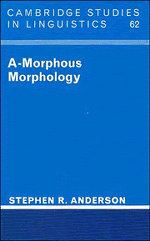Book contents
- Frontmatter
- Contents
- Acknowledgments
- Introduction
- 1 The study of word structure
- 2 Why have a morphology at all?
- 3 Is morphology really about morphemes?
- 4 The interaction of morphology and syntax
- 5 The theory of inflection
- 6 Some complex inflectional systems
- 7 Morphology in the lexicon: derivation
- 8 Clitics are phrasal affixes
- 9 The relation of morphology to phonology
- 10 How much structure do words have?
- 11 Composites: words with internal structure
- 12 Morphology and the typology of languages
- 13 Morphological change
- 14 Morphology as a computational problem
- References
- Index
6 - Some complex inflectional systems
Published online by Cambridge University Press: 10 January 2011
- Frontmatter
- Contents
- Acknowledgments
- Introduction
- 1 The study of word structure
- 2 Why have a morphology at all?
- 3 Is morphology really about morphemes?
- 4 The interaction of morphology and syntax
- 5 The theory of inflection
- 6 Some complex inflectional systems
- 7 Morphology in the lexicon: derivation
- 8 Clitics are phrasal affixes
- 9 The relation of morphology to phonology
- 10 How much structure do words have?
- 11 Composites: words with internal structure
- 12 Morphology and the typology of languages
- 13 Morphological change
- 14 Morphology as a computational problem
- References
- Index
Summary
The two immediately preceding chapters have described a set of mechanisms that allow us to describe inflectional systems. These include a notion of Morphosyntactic Representation and a class of Word Formation Rules which operate to provide the (inflected) phonological form of a lexical stem as it interprets a particular syntactic position. In the present chapter, we exemplify the use of that apparatus in the description of two fairly complex inflectional systems: Georgian and Potawatomi.
Although obviously very different in their overall structure, these two languages have at least one thing in common. In certain cases, the pattern of formal markers associated with the arguments of a Verb is the reverse of what we might otherwise expect in light of purely syntactic evidence. In each case, the existing literature proposes analyses on which actual syntactic restructuring takes place. Such analyses, however, have been motivated by nothing other than the morphology itself, and are apparently based on the assumption that the correspondence between syntactic structure and morphological categories ought to be completely transparent. Insofar as this is not the case, such a view requires that the syntactic account be extended or deformed to bring sentence structure into accord with the apparent requirements of the morphology. Furthermore, at least for Georgian (see Anderson 1984b) and for Cree (another Algonquian language quite similar in structure to Potawatomi: see Dahlstrom 1986), substantive syntactic evidence exists to show that such restructuring of clauses does not take place in the way suggested by the morphology.
- Type
- Chapter
- Information
- A-Morphous Morphology , pp. 136 - 179Publisher: Cambridge University PressPrint publication year: 1992



